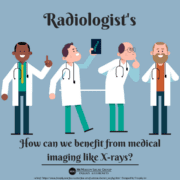Radiologist
Radiologist
This article discusses details on the profession of radiology including what a radiologist is, who and what they treat, and some of the common types of medical equipment they use.
What is a radiologist?
A radiologist is a doctor who specializes in the treatment of illness and disease through medical imaging techniques. They, just like other doctors, have completed medical school and completed a residency and additional special training. Some of radiologists techniques include (but are not limited to):
- X-ray
- Computed tomography (CT)
- Magnetic resonance imaging (MRI)
- Nuclear medicine
- Positron emission tomography (PET)
- Fusion imaging
- Ultrasound
The importance of a radiologist is high because when an injury isn’t clear a radiologist will test via medical images and direct the patient to the specific care they need. Sometimes multiple medical screens are necessary in order to get the most accurate finding of the injury or illness.
What types of injuries do they treat?
The types of injuries radiologists treat can range from broken bones to cancer. With the use of medical imaging, radiologists can see what is going on inside the body. Injuries that a radiologist might treat include (but are not limited to):
- Cancer
- Broken bone
- Heart disease
- Blood-related disease
- Digestive problems
- Headache and migraine
- Brain disease
What types of treatment do they provide?
The types of treatment a radiologist provides are mostly based on medical imaging. Some of the techniques that a radiologist might use include (but are not limited to):
- Breast imaging
- Cardiovascular Radiology
- Chest Radiology
- Emergency Radiology
- Gastrointestinal Radiology
- Genitourinary Radiology
- Head and neck Radiology
- Musculoskeletal Radiology
- Neuroradiology Radiology
- Interventional Radiology
- Nuclear Radiology
- Radiation Oncology
With the variety of techniques a radiologist has, they can approach a disease, injury or illness in many different ways. Similar to a sonographer using an image for an ultrasound, Interventional radiology is ‘image-guided’ surgery, meaning the image is used as a tool for the surgeon to see more clearly. A radiologist might use an X-ray image to diagnose a traumatic injury someone may have suffered from in a car crash.
A radiologist is a physician who is specially trained to obtain and interpret medical images, such as an X-ray. They are trained to interpret the images and understand what is functioning normally and if there are any abnormalities. Sometimes it is clear that someone has a broken bone or has a migraine, but a radiologist can see inside the body and understand if there are any underlying issues that are of concern. If the radiologist finds something, they can then treat the patient or refer them to another specialist. For example, let’s say someone twists their ankle and they continue to walk on it. They may say to themselves, “I twisted my ankle but I’m fine. I don’t need to see a doctor”. They might have broken their ankle and a few bones in their foot – if they continue to walk on it and don’t seek any treatment they may make the injury worse. If they saw a radiologist and got an X-ray, the radiologist could recommend certain medicine and therapy for a speedy and full recovery, instead of making it worse.
X-ray
The X-ray was invented in 1896, and have served as a primary tool for physicians since its inception. An X-ray is “an electromagnetic wave of high energy and very short wavelength, which is able to pass through many materials opaque (not able to see through) to light”. In other words, an X-ray machine sends tiny waves through an object and the waves collect the data, sending it to a computer. The data is then collected and used for research and diagnosis. Then the radiologist or doctor can explain the images to the patient.
MRI
An MRI is similar to an X-ray, but it images the water molecules in the body and takes images of tissues. Radiofrequency and electromagnetic field are used to take medical images of the soft tissue (via water molecules). The specialty for an MRI is soft tissue (tissue that connects, supports or surrounds parts of the body, e.x. muscles, tendons, etc.).
CT Scan
A CT scan or ‘Cat Scan’ is a use of radiation waves and takes cross-sectional images of the body using a small beam that sends the waves through the body. In other words, a CT scans the body using radiation instead of an X-ray. The results are then studied by the doctor and shown to the patient, and any abnormalities are addressed.












